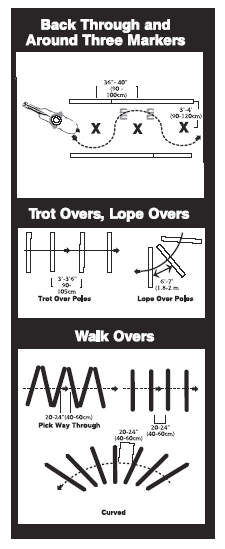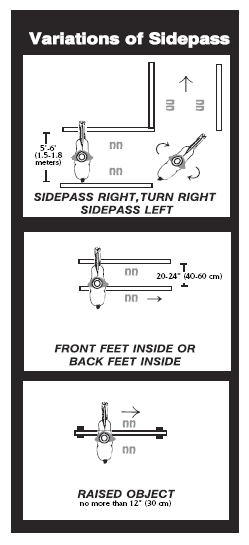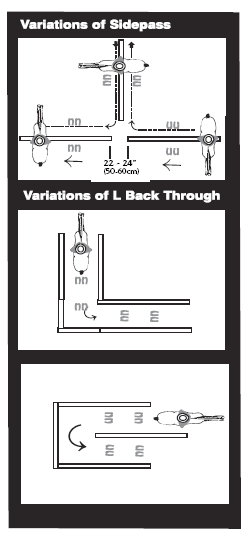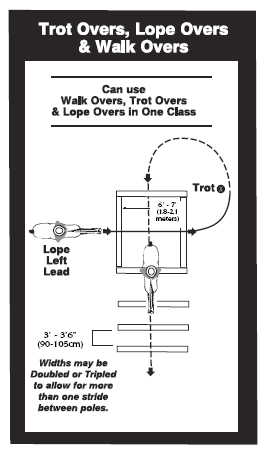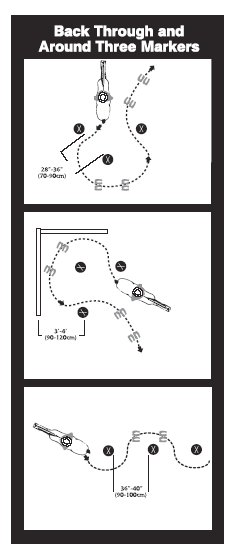
454. TRAIL.
(a)
This class will be judged on the performance of the horseover obstacles, with emphasis on manners, response to the rider, and
quality of movement. Credit will be given to horses negotiating the
obstacles with style and some degree of speed, providing correctness
is not sacrificed. Horses should receive credit for showing attentiveness
to the obstacles and the capability of picking their own way
through the course when obstacles warrant it, and willingly responding
to the riders cues on more difficult obstacles.
(b)
Horse shall be penalized for any unnecessary delay whileapproaching or negotiating the obstacles. Horses with artificial
appearance over obstacles should be penalized.
(c)
Horses must not be required to work on the rail. The coursemust be designed, however, to require each horse to show the three
gaits (walk, jog, lope) somewhere between obstacles as a part of its
work and quality of movement and cadence should be considered as
part of the maneuver score.
While on the line of travel betweenobstacles, the horse shall be balanced, carrying his head and neck
in a relaxed, natural position, with the poll level with or slightly
above the withers. The head should not be carried behind the vertical,
giving the appearance of intimidation, or be excessively nosed
out, giving a resistant appearance.
Gait between obstacles shall be atthe discretion of the judge.
(d)
The course to be used must be posted at least one hourbefore scheduled starting time of the class.
(e)
Scoring will be on the basis of 0-infinity, with 70 denotingan average performance. Each obstacle will receive an obstacle score
that should be added or subtracted from 70 and is subject to a penalty
that should be subtracted. Each obstacle will be scored on the following
basis, ranging from plus 1 1/2 to minus 1 1/2: -1 1/2
extremely poor, -1 very poor, -1/2 poor, 0 correct, +1/2 good, +1
very good, +1 1/2 excellent. Obstacle scores are to be determined
and assessed independently of penalty points. Penalties should be
assessed per occurrence as follows:
(f)
The following deductions will result:0 - SCORE
-Use of more than one finger between reins
-Use of two hands (except in Snaffle Bit or Hackamore classes designated
for two hands) or changing hands on reins; except for junior horses
shown with hackamore or snaffle bit, only one hand may be used
on the reins, except that it is permissible to change hands to work an
obstacle.
-Use of romal other than as outlined in 443(e)
-Performing the obstacles other than in specified order
-No attempt to perform an obstacle
-Equipment failure that delays completion of pattern
-Excessively or repeatedly touching the horse on the neck to lower the
head
-Fall to the ground by horse or rider
-Failure to enter, exit or work obstacle from correct side or direction
,including overturns of more than 1/4 turn
-Failure to follow the correct line of travel within or between obstacles
-Failure to work an obstacle in any manner other than how its described
by the course
-Riding outside designated boundary marker of the course
-Third refusal
-Failure to demonstrate correct lead or gait, if designated
-
Faults, that occur on the line of travel between obstacles, which willbe cause for disqualification, except in novice amateur or novice
youth classes, which shall be faults, scored according to severity:
(1)
head carried too low (tip of ear below the withers consistently)(2)
over-flexing or straining neck in head carriage so the noseis carried behind the vertical
consistently.1/2 POINT
-Each tick of log, pole, cone or obstacle
1 POINT
-Each hit of or stepping on a log, pole, cone or obstacle
-Break of gait at walk or jog for two strides or less
-Both front or hind feet in a single-strided slot or space
-Skipping over or failing to step into required space
-Split pole in lope-over
-Failure to meet the correct strides on trot over and lope over log
obstacles
3 POINT
-Break of gait at walk or jog for more than 2 strides
-Out of lead or break of gait at lope (except when correcting an
incorrect lead)
-Knocking down an elevated pole, cone, barrel, plant obstacle, or
severely disturbing an obstacle.
-Stepping outside the confines of, falling or jumping off or out of an
obstacle with one foot
5 POINT
-Dropping slicker or object required to be carried on course
-First refusal, balk, or attempting to evade an obstacle by shying or
backing more than 2 strides away
-Letting go of gate or dropping rope gate
-Use of either hand to instill fear or praise
-Stepping outside the confines of, falling or jumping off or out of an
obstacle with more than one foot
-Blatant disobedience (kicking out, bucking, rearing, striking)
-Second refusal, balk, or attempting to evade an obstacle by shying or
backing more than two strides away
-Failure to complete obstacle
-Faults, which occur on the line of travel between obstacles, scored
according to severity:
(1)
head carried too high(2)
head carried too low (tip of ear below the withers)(3)
over-flexing or straining neck in head carriage so the nose iscarried behind the vertical
(4)
excessive nosing out(5)
opening mouth excessively(g)
Management, when setting courses, should keep in mind thatthe idea is not to trap a horse, or eliminate it by making an obstacle
too difficult. All courses and obstacles are to be constructed with safety
in mind so as to eliminate any accidents. If difficult courses are set,
junior trail should be less difficult. When the distances and spaces are
measured between all obstacles, the inside base to inside base measurement
of each obstacle considering the normal path of the horse, should
be the measuring point. Enough space must be provided for a horse to
jog [at least 30 feet (9 meters)] and lope [at least 50 feet (15 meters)]
for the judges to evaluate these gaits.
(h)
If disrupted, the course shall be reset after each horse hasworked. In the case that a combination of obstacles are used, the course
cannot be reset until the contestant finishes the entire course regardless
of where any disruption occurs.
(i)
At least six obstacles must be used, three of which must be fromthe mandatory list of obstacles and at least three different others selected
from the list of optional obstacles.
(j)
Mandatory obstacles:(1)
Opening, passing through, and closing gate. (Losing controlof gate is to be penalized.) Use a gate which will not endanger horse
or rider. If the gate has a metal, plastic or wooden support bar under the
opening, contestants must work the gate moving forward through it.
(2)
Ride over at least four logs or poles. These can be in astraight line, curved, zigzag or raised. The space between the logs is to be
measured and the path the horse is to take should be the measuring
point. Trotovers and lopeovers cannot be elevated in novice classes. All
elevated elements must be placed in a cup, notched block, or otherwise
secured so they cannot roll. The height should be measured from the
ground to the top of the element. Spacing for walkovers, trotovers, and
lopeovers should be as follows or increments thereof.
(A)
The spacing for walkovers shall be 20 to 24 (40cm to 60 cm) and may be elevated to 12 (30 cm). Elevated
walkovers should be set at least 22 (55 cm) apart.
(B)
The spacing for trotovers shall be 3 to 36(90cm-105cm) and may be elevated to 8 (20 cm).
(C)
The spacing for lopeovers shall be 6 to 7 (1.8 to2.1 meters) or increments thereof, and may be elevated to 8 (20 cm).
(3)
Backing obstacle. Backing obstacles to be spaced a minimumof 28 (70 cm). If elevated, 30 (75 cm) spacing is required.
Entrants cannot be asked to back over a stationary object such as a
wooden pole or metal bar.
(A)
Back through and around at least three markers.(B)
Back through L, V, U, straight, or similar shapedcourse. May be elevated no more than 24 (60 cm).
(k)
Optional obstacles, but not limited to:(1)
Water hazard (ditch or small pond). No metal or slickbottom-boxes will be used.
(2)
Serpentine obstacles at walk or jog. Spacing to be minimumof 6 ( 1.8 meters) for jog.
(3)
Carry object from one part of arena to another. (Onlyobjects which reasonably might be carried on a trail ride may be
used.)
(4)
Ride over wooden bridge. (Suggested minimum widthshall be 36 (90 cm) wide and at least six feet long). Bridge should
be sturdy, safe and negotiated at a walk only.
(5)
Put on and remove slicker.(6)
Remove and replace materials from mailbox.(7)
Side pass [may be elevated to 12 (30 cm) maximum].(8)
An obstacle consisting of four logs or rails, each 5 to 7(1.5 to 2.1 meters) long, laid in a square. Each contestant will enter the
square by riding over log or rail as designated. When all four feet are
inside the square, rider should execute a turn, as indicated, and depart.
(9)
Any other safe and negotiable obstacle which could reasonablybe expected to be encountered on a trail ride and meets the
approval of the judge may be used.
(10)
A combination of two or more of any obstacle isacceptable.
(l)
Unacceptable obstacles:(1)
Tires(2)
Animals(3)
Hides(4)
PVC pipe(5)
Dismounting(6)
Jumps(7)
Rocking or moving bridges(8)
Water box with floating or moving parts(9)
Flames, dry ice, fire extinguisher, etc.(10)
Logs or poles elevated in a manner that permits such to roll.(11)
Ground ties(m)
The judge must walk the course and has the right and dutyto alter the course in any manner. The judge may remove or change
any obstacle he deems unsafe or non-negotiable. If at any time a trail
obstacle is deemed to be unsafe by the judge, it shall be repaired or
removed from the course. If it cannot be repaired and horses have
completed the course, the score for that obstacle shall be deducted
from all previous works for that class.

